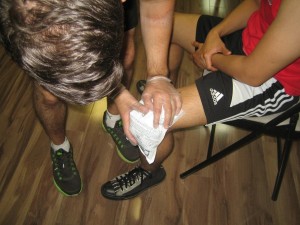If an individual slips on a trail and scrapes the surface of the skin, you have to be prepared to provide care while outdoors. If the abrasion is not cared for properly, a minor wound can lead to bigger issues when staying outdoors for a long time. It is vital to plan ahead by bringing along a wilderness first aid kit and be prepared to manage wounds.
Risk for infection
Bacteria are responsible for causing an infected wound. If an individual sustained an abrasion while outdoors, the environment around contains large amounts of bacteria. In addition, there might not be ready access to purified water for cleaning the wound.
Remember that personal hygiene can be difficult while in the outdoors which can result to more bacteria around a wound if there is more on the skin or clothing, especially if the individual has not taken a bath or washed his/her clothing for several days. There are steps to follow to help keep an abrasion uncontaminated until it starts to heal or when medical treatment is available.

Bleeding control
An abrasion is a soft tissue injury usually in the form of scrapes or cuts. Oftentimes, it might appear as a road rash in which the upper skin layer has been scraped off. Take note that abrasions do not bleed profusely but if the bleeding does not stop, you have to apply direct pressure over the wound and elevate it higher than the heart.
If sterile gauze pads are available, place them over the wound and apply pressure. Add extra layers of gauze until the bleeding ceases. If gauze is not available, you can utilize an extra piece of clothing or a towel.
Cleaning the abrasion
Once the bleeding is controlled, you have to clean the wound. Remove any debris or dirt present on the skin surface or in the wound. You can use tweezers if available to remove debris that are difficult to dislodge.
The next step is to clean the wound using the cleanest water available. After cleaning, rinse the wound and the surrounding skin using soap and clean water if available and then irrigate the wound using water.
Protecting the wound
You can protect the abrasion by wrapping it using sterile gauze and securing in place using an athletic tape. In case sterile gauze is not on hand, you can improvise by covering the wound using a piece of cloth that has been scrubbed clean with water and soap. Tie the cloth around the wound or secure using duct tape.
Monitor the wound
Always remember that keeping the abrasion hygienic is the ideal way to prevent infection from developing. Change the bandage and clean the wound every 12 hours using water and soap. You have to watch out for signs of infection such as tenderness, redness, swelling or discharge. In case the signs of infection are present, continue to clean and irrigate the wound and then seek medical care.
